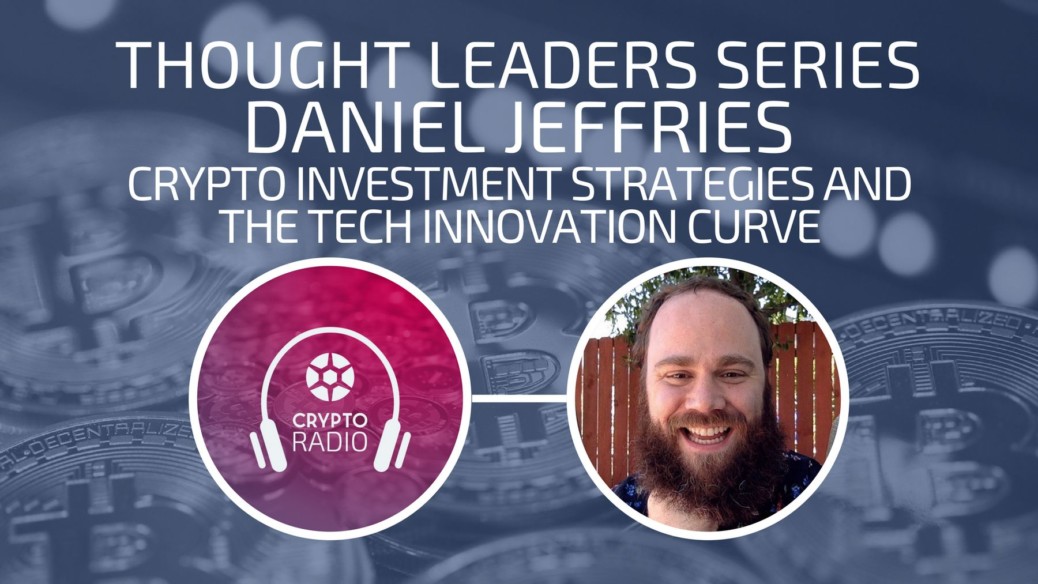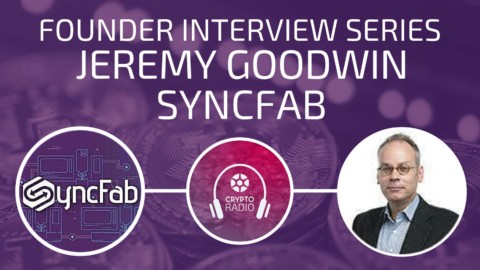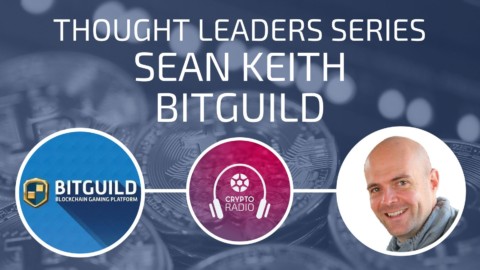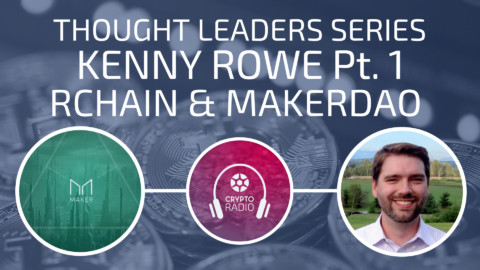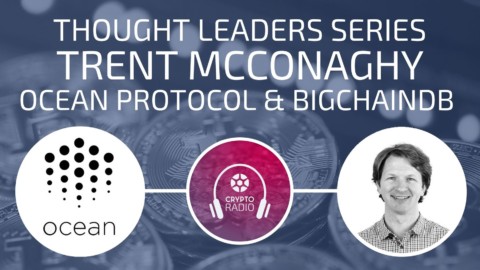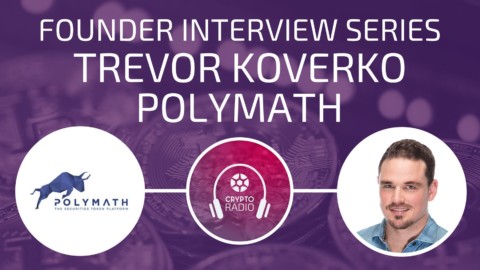Podcast: Play in new window | Download
Euvie: Hi everyone, I’m your host Euvie Ivanova. Welcome to the third part of our interview with Daniel Jeffries. In this episode, we talk about Daniel’s best alt coin investment strategy and understanding the curve of technological development and adoption. To get the show notes from this episode go to cryptoradio.io/daniel3. To hear the first and second part of this interview, go to cryptoradio.io/daniel1 and cryptoradio.io/daniel2. [00:00:30] This episode was brought to you by bitguild.io. Bitguild is a new gaming platform built using blockchain technology.
Their mission is to redefine the relationship between gamers and game developers. On the Bitguild platform, gamers maintain full ownership and control of their virtual items, which are stored on the blockchain. They can transfer items and progress between compatible games and they can make in game transactions safely and cheaply, and sometimes free. Developers who join the platform will get a direct link to an established [00:01:00] player base, a strong community, and a network of like-minded developers building on the same platform. Developers will also have the potential for direct game development funding from Bitguild. The first version of the Bitguild portal is now live. You can login with Meta Mask, buy the Plat token, and play Bitguild’s first game, Ether Online.
They now have a full inventory wallet system for in game items. In the coming weeks, the market place will be implemented and several independent developers are joining the site to bring their unique games to the Bitguild [00:01:30] family. Go to cryptoradio.io/play to start playing and join the Bitguild official Discord server to connect with the team.
Mike: Welcome to Crypto Radio. We interview the top thinkers and entrepreneurs in the blockchain and cryptocurrency industry. We also cover topics like trading, investing, and ICOs. We’re your hosts Mike Gilliland, Michael Paul, Chris Sparks, and Euvie Ivanova. We’re entrepreneurs, crypto investors, and co-founders of a new blockchain investment platform called cosyndicate.io. [00:02:00] We created Cosyndicate and Crypto Radio to make crypto investing a better experience for you. If you’re new to the show and you’d like a list of our top episodes and resources, go to cryptoradio.io/start.
If you like our podcast, you can subscribe, share, and follow us on social media and leave us a rating and review on iTunes and elsewhere. It helps others find the show and we really appreciate it. You can find all those links at cryptoradio.io/start.
Euvie: [00:02:30] You wrote this book about mastering shit coins, maybe we can talk about that for a bit.
Daniel: Sure. Mastering Shit Coins is one of my most popular articles of all time. I’ve not yet woven it into a book but I will. I also did the podcast on it, that’s the Daily Post Human, which you can see on dailyposthuman.com. It is what I call my mini VC strategy. This is a strategy where you are not trading regularly. [00:03:00] It is more of a buy and long-term hold strategy with the added advantage of actually having a plan to sell. Most buy and hold is more of a tribal awareness, which is more like a survival instinct. Buy and hold is great but not when you’re going to burn all of your cash, you actually have a plan to sell, whether that’s 2 years, or 5 years, or 10.
Mastering Shit Coins was more about, again, what I call the mini VC strategy. If you think about how VCs invest their [00:03:30] money, what they generally do is take a portfolio of maybe 20 or 30 different companies that they’re putting their money into. Maybe they’re putting a million dollars into those 30 companies. They fully expect 80 to 90 percent of those companies to be worth practically nothing or go to 0. Let’s pretend that it’s 80 percent goes to zero. [00:04:00] A company can go bad for any reason just like a project can go bad for any reason. It could be personalities, it could be somebody gets hit by a bus, it could be somebody gets sick of the project and leaves a key developer, could be relationships, it could be it was too ambitious, it could be the founders at each other’s throat, it could be a divorce, it could be anything that kills a company or a project.
Even if it was a tremendous idea and you had great people and all of the funding in the world. 80 percent just [00:04:30] knocked out of existence. The other 10 percent are the ones that are good performers. Maybe they’re not the rock stars, they’re not the ones that go to the moon, the one you read about. They’re not the one that makes somebody famous. They’re good performers, they’re a good return on investment. The last 10 percent is really the ones that go crazy, they go to the moon. That’s the rocket ship. The rocket ship is then the one that really makes up for all of that 80 percent loss.
[00:05:00] Really, that is the strategy for me, since they have a very long time horizon. The amateur ones have it at about 3 years, the longer ones have it at 5, 8, or 10 years timeframe, which is a very long period of time that post people are not comfortable with. The general strategy I would say is you look at the different categories of coins that are out there – you’re looking at something like platform coins, these are the ones that are trying to build the internet, the next wave of the internet, a centralized version of the internet. [00:05:30] That’s where things like Ethereum and Neo, Iota, Eos, that’s where those waves, all those types of things, that’s where those platforms live. Those are the most complex things to build.
They’re very challenging, they’re going to take a long time to get right. We are reinventing the wheel in many cases. We have nothing to go on. We’re inventing something out of nowhere. People get very impatient nowadays and they say, “Crypto’s been around [00:06:00] eight years and nothing’s happened.” Yeah, artificial intelligence was around 50 before anything happened, right? We are very impatient today with the change rate of progress and that’s just not historically how things work. Things go through a series of iterations and changes. [inaudible [0:06:18] recording is a category of technology and beta max, VHS, laser disk, DVD, Blueray, DVR, or iterations of that technology.
[00:06:30] Each one improves upon the past, right? We are very much in the modelty era here, the beta max era of this technology. These platform coins are going to take their time. There are also things that function more like currencies, either behave like a precious metal, like a Bitcoin, or a spender style coin that is going to be moved around a lot more. Then there’s also the privacy coins, Manero and things like that that are more acting [00:07:00] like analogues to cash. There are currencies, there’s a basket of that. There are utility coins, which are more like Fintech coins for instance, like Excel M, those types of things where you can consume a basket of those.
There will be security coins and I think they’re going to be incredibly popular. The regulation and all the moves that have to happen at a societal level for that to be the case are in motion are now. It’s a slow process. Eventually, [00:07:30] many, many assets will be tokenized and securized. The template laws are already on the books in places like Delaware, which is the business capital of the world in many respects – business capital in America, for sure, and in many ways the world. There are other centres like Switzerland and Singapore and such. That tends to act as a Litmus test for how the laws will eventually function at the federal level.
There’s a reason [00:08:00] everyone incorporates in Delaware. They have all the judges and all the people are incredibly trained in corporate law and how these things work. The entire court system is totally streamlined for it. It’s really this specialty and that’s been the history of the United States in that each different state acts as a lab for larger federal laws. We will get there. Security coins will be a basket. It’s really by picking a number of the projects in each of these [00:08:30] categories, buying some of them, and basically just hanging onto them for five years or more. I think that could be a very effective strategy for the average investor who would like to dabble in crypto but not necessarily make it a full-time job, like being a day trader or even a swing trader.
Just something where you don’t want to try to develop an algorithmic system, that is a very effective algorithm that has worked historically over time. There’s no guarantee and maybe all the [00:09:00] projects go to bust but this is part of my strategy and about, I would say, 20 to 30 percent of my portfolio in crypto lives in that particular strategy.
Euvie: Yeah, it’s been my strategy, as well. I think in the crypto space, things move a bit faster than in the VC world. That timeframe may be shorter to see returns but, ultimately, like you said, with a lot of these platform coins, it is going to take a few years before we see [00:09:30] a real, functioning product. A lot of these ICOs are being raised on an idea. Maybe not so much this year, people are getting a bit more serious and they, at least, have an alpha version of the platform ready. Still, it’s going to be a while before they’re actually functioning and have millions of users and all of that.
Daniel: Yeah, it’s so early. The crypto assets are so small and people think, “It’s too late, I already missed the big run.” No, you did not. You didn’t. [00:10:00] It is so early in this space and there are so many things that have to happen. When you look at even the basics, right, of how some of these applications work… I was excited about [inaudible [0:10:11] recently because there’s a debate about is it too centralized. It’s like, look, these are all iterations, we’re still figuring out consensus technology, it’s imperfect, we’re not there yet. I’m willing to let all these different consensus protocols playout. Eventually, we’ll have hundreds of them and we’ll hit upon the [00:10:30] two or three best ones.
It’s not just proof of work and proof of stake. There will be hundreds of others ones that nobody has even thought of yet. Give that time. I was interested in them because I felt like maybe there was a real competition with Ethereum for once. They’d also pushed the rock forward on a few things, right? They had the idea that you could have an application where the developer pays for your ability to use it. That means you could, theoretically, just go to an app store, download an application, and use it [00:11:00] without actually loading any crypto into it. The developer is going to pay for you to do it. To me, that makes perfect sense, because if you look at how the way it’s developing right now, you would have to go get on an exchange, get KYC, wire money from your bank account into the exchange, buy a utility coin, move it to a wallet, download an application, top off your application to do [00:11:30] something. That is a nonstarter. It’s just a nonstarter.
Mark my words, it will never, never work like that in the real world, okay? The way that [inaudible [0:11:42] said succinctly was if you went to the Amazon web page and it cost you three cents to load the page, you would never load the page. This kind of early adopter stuff that we’re all willing to deal with because we’re techies or have a background, [00:12:00] if you don’t understand what I’m saying then go find a relative – your mother, your brother, your sister, your best friend. Try to walk them through that process. If you can do it in less than two weeks, you are a freaking genius. The average consumer is not going to function like that.
There are so many little quirks and hurdles to how this technology is developing and it is going to take time for these best practices and standards and things to play out. [00:12:30] People have got to be patient. Somebody once said that the market is designed to take money from impatient people and give it to patient people. If you’re going to burn one thing into you brain from this podcast, burn that into your brain.
Euvie: Yeah. Even the blockchain technology itself, it’s been such an overhype word that even ice tea [00:13:00] companies are changing their name to blockchain ice tea and their stock is going up in price because people are so crazy about just the word blockchain. It might end up being, it’s plausible, that blockchains might just be the Myspace of this technology space. Maybe we’ll come up with something better and more efficient, faster, more decentralized, more user-friendly, whatever. It might be the blockchains won’t even be around in another couple years but some second, third, fourth [00:13:30] generation technology will be.
Daniel: I agree 100 percent. I actually have a talk about this where I say that blockchain is actually a limiting frame on the way that you think about this technology. In fact, I mentioned earlier that there is a difference between a category of technology and an iteration of the technology. The reason most people struggle to predict the future is they focus on the iteration of the technology. They look at beta max and they go, “It [00:14:00] won’t record long enough and it’s ugly, it will never work.” The way the technology develops, they project that indefinitely into the future. The way the technology develops is the people who are the engineers are looking at the flaws in the current iteration and thinking, “How do I solve that?”
That’s what the next iteration moves the rock forward a little bit. The category always succeeds, it’s the iterations that fail. In fact, no historical technology really fails as a category. Whenever I challenge people to go back [00:14:30] and look at technology and find me an actual technology that failed. When I see these snarky, snarky articles about blockchain and crypto are going nowhere. I’m like, “Go find me an actual technology that failed, like steam powered things, steam powered engines.” You can point out 30 iterations that failed but you will never be able to find out a category of technology that has failed. You just can’t do it, it doesn’t exist. You can point to a plane crash, you can point to AT&T lines [00:15:00] going down in a mass communication network. You can point to a bridge collapse. Those are individual iterations – bridges, planes, mass communication survives in its [inaudible [0:15:10] form. It iterates. Blockchain, to me, is an iteration. It is the first spark of fire in the caveman of this new world, right? It is not the end all be all, it is the first solution to a previously unsolvable problem. Zooko’s triangle of [00:15:30] you can’t have it human understandable plus decentralized, I’m not sure what the third part is right now.
Again, there’s this… You probably couldn’t solve it, you can only put two of the pieces of the triangle together, right? Bitcoin comes along and solves for all three parts. Then everybody leaps out of that space, they go, “This previously unsolvable problem, now I know how to solve it,” and they leap into what I call the Satoshi box. They go and they solve the problem in the exact same way. [00:16:00] They say, “This is the only way we can ever solve this.” That is nonsense, that is not how it will work. We’ll have – I call this decentralized consensus technology. It doesn’t exactly roll off the tongue like blockchain but it is decentralized consensus technology. It is a way for large groups of folks without a central authority able to make decisions collectively, including different parts of the group that agree, [00:16:30] different parts that don’t agree, and different parts that are hostile.
It is an entire system of entities and people making a decision about how to do things collectively. That is what the revolution is really about. It is making decision across long-distance and blockchain is really just the first most brute force, most basic method. It is very effective but it is entirely likely it will not exist. It might exist for a very specific purpose or [00:17:00] as a subset, but we are already starting to see different groups come up with different technologies in terms of how it functions. I just interviewed [inaudible [0:17:08] and I’m writing an article on them now. They have a slogan, “Blockchain, your days are numbered.” They are already claiming that they can get to ease of level transactions right now with the technology. They’re about to release I think their full alpha in June or so. They’ve been working on it for six years. They’ve iterated through different versions where they’ve failed.
[00:17:30] They tried blockchain and they tried an alternative to blockchain and that didn’t work. They just kept iterating and iterating and iterating and came up with their won piece of the technology. We’re seeing other groups do this, as well. This is largely inevitable. It is about being flexible and understanding that this is a process. It could be a process that takes… Yeah, it moves faster but it could be 20 or 30 years, honestly. We’re going to see killer apps [00:18:00] earlier than that, low hanging fruit apps than that in the next couple of years, five years. We’re going to start to see use cases good and bad for the technology as it exists today in the next decade. Really, maybe the true revolution is 20 years from now, 30 years from now, 50 years from now.
We all like to think the singularity is near and we’re accelerating towards this tech topia. To me, as a sci-fi [00:18:30] writer, I love that stuff. It’s great, goes into all my novels. As a practical free-thinking individual, I think it’s probably nonsense. A lot of folks are going to come to the end of their life and be very disappointed when they die like everybody else. We’re accelerating. I don’t think we’re quite at the super take off stage. These technologies are still going to take a practical amount of time to really change the way the world works. It could be 100 years.
Euvie: [00:19:00] Yeah. I think some of the industries that are notoriously known for adopting new technologies like gambling, gaming, porn, are probably going to be the ones where we see those killer apps. Because the appeal of the applications in those industries often don’t have much to do with the underlying technology itself, they rely more on the excitement which smooths out any glitches or problems. I think that excitement actually in those industries is exactly why people are so tolerant to [00:19:30] these kind of half-functioning apps. Game physics is a popular meme generating area where games work poorly but people enjoy them anyway because it’s hilarious. It’s very possible that blockchain will see killer apps in those areas.
People talk about governments using blockchains or them being used in the medical industry and these kind of critical applications. I think it will be a while before we see them. I was in Oslo [00:20:00] a couple weeks ago and I spoke in front of a room of politicians and investors, like the minister of foreign development of Norway was there. I was talking about blockchain and he asked me, “Do you think that we should be using blockchain in our elections?” I said, “No, it’s just too early. This is a baby technology. It’s just taking its first steps, it’s not ready to be used in something serious like governments. Give it some time. It’s going to get there maybe,” or maybe there will be another iteration.
[00:20:30] Because we have the internet now and things spread so fast and because there’s a financial application in this technology, people get really, really excited about it early on and we get ahead of ourselves I think and where it actually is.
Daniel: I think I wrote it in the beginning of one of my articles, “The bubble popped and the naysayers were right,” and I said, “Good.” Then I said, “Have I become a naysayer? Do I agree that Bitcoin is worthless and all this?” The answer is no, it’s just that with all this frothy excitement, it became hard [00:21:00] for people to focus on actually developing the damn applications and making them useful and there’s this brutal spotlight on them at all times, this fear, “Oh my God, what if it takes over the world and crashes all of the world’s currency?” Hang on there cowboys, this is human insanity meter kicking up a bunch. The fear, uncertainty, and doubt. This crazy that goes along with anything.
“It’s speculation, we’ve got to stop this thing.” Just shut up, [00:21:30] calm down, sit the fuck back. It’s okay. I actually, for me, when it deflated, despite I love a good bubble boom like anybody, I like raking it in and feeling like I’m a genius. It really is good for the industry. The industry needed to have that spotlight taken back, so that people can keep working on the whiteboard, they can keep working on the code, they can keep [00:22:00] making mistakes and iterating through ideas. This is going to take some time, people need to have patience. Yeah, the internet and mass communication technology really magnifies this stuff and just makes it feel like we’re accelerating all the time and going faster and faster.
We are in some respects, but technology takes a long time. It really does. I think I used an example in one of my articles of Velcro. [00:22:30] The guy had the idea for Velcro seeing these [inaudible [0:22:34] that stuck to his friend’s sweater when they were on a hike. It was 10 years of him going through materials and developing it and then it was another 10 years to perfect it and build a company. Then when he launched the company, he thought, “Bam, easy street baby, the orders are going to roll in.” It was another five years before NASA was looking at it and they were about to put men on the moon [00:23:00] and they were like, “It’s really hard to get people in and out with laces or zippers, what are we going to do?” And they fell Velcro. That was the beginning.
That’s 25 years from conception to reality. That is realistic. The human time scale has not changed, even with artificial intelligence and all these things speeding up our ability to do certain things. Real innovation, real solutions take time. Artificial intelligences [00:23:30] are not smart, they’re pattern matching system. They solve a problem in the exact same way that it’s always been solved. A human is still unique. If they want to put someone on the moon, they can take everything they’ve ever learned, abstract a way the core, platonic vision of that, design two or three possibilities of how to get there, then design an exact, precise solution that ahs never existed before to land [00:24:00] that rocket on the moon.
That is something that the computers don’t do well yet, that is something the average person doesn’t do well. That is a true breakthrough and these things are rare, they take time despite what a bunch of nonsense and reports are telling you that the AIs are rising up and having emergent consciousness. We’ve had a tremendous amount of acceleration in machine intelligence and exactly zero percent success [00:24:30] evolution in machine consciousness. Zero. In the same way, when it comes to crypto technology, there are some brilliant breakthroughs and there are many breakthroughs to come that are going to take a genius staring at a whiteboard and drinking Redbulls 24 hours a day for 5 years to solve.
Euvie: Yeah. I think there’s also an element of being in the right place at the right time. Sometimes the technology might be developed [00:25:00] for a few years but then some sort of zeitgeist will happen where a bunch of factors come together where it’s exactly the thing that’s needed to solve a specific problem, then it takes off. It could be something like that, as well.
Daniel: Yeah, there’s an example actually in a great article I found the other day where he was talking about how, when you look at the hard drive that was developed in the 50s, the concept of the hard drive. When the first hard drive came out in 60s or 70s, forgive me pedantic people, I don’t have the dates [00:25:30] perfectly memorized, the hard drives were getting – as they first came out – the commercial hard drives were getting a couple megabytes or whatever a year for 20 years or something. Then all of a sudden, we started getting 50 megabytes, to 100, to 250, to 500, to a gigabyte, to 10 gigabytes, to 50 gigabytes, to terabyte.
It was going very quickly, right? Really, that’s a Sigmoid curve if you look at it. That’s that classic S curve or flat S curve. [00:26:00] It’s not a perfect S curve, that’s probably the wrong description. It’s like going up a hill that flattens out. The first part is that breakthrough, it’s really low and flat, very hard to make movement along it. Then you start to have enough different breakthroughs coming together and interrelating, that people who are not necessarily the creator or the inventor start to look at and understand and go, “I’ve got to make that better. I’m going to take my classic engineering skills or coding skills and I’m going to change the material or the sort function or whatever and I’m going to make this faster [00:26:30] and I’m going to stick it together into a library.”
All of a sudden, that starts to move faster and have this rapid explosion of progress for a period of time. Then all of a sudden, as you get further up the Sigmoid curve, you start to run into trouble. You’ve had all these big breakthroughs and it seems like it’s going to never end but then you start to find the limitations of the technology and the progress starts to slow down. Each new innovation it’s still happening but it’s taking longer to get there as you go up the curve. Then you start to hit this point of diminishing returns [00:27:00] where you’re just not going to get anywhere and any increment of progress is painful and long and it starts to flatten out again. Then you need a new technology or a new paradigm to fix things. That’s the way that it works, it’s the way that it works in all things.
Euvie: Yeah. It reminds me of the Cambrian explosion theory of evolution, how it doesn’t happen in this linear progression but in these long periods of seeming stagnation and then just insane jumps, where a lot of new organisms are [00:27:30] evolved. I think it’s the same with technology where, for a long time, it seems like almost nothing is happening, then suddenly a bunch of factors come together and very rapid changes happens for a while and then it flattens out again. Again, going with the same analogy, this is why your strategy of investing in a bunch of different iterations of the same thing is valuable, because you don’t know during that rapid change process which thing is going to survive.
Daniel: Right. I encourage people to get rid of your biases. [00:28:00] You see all of these people like, “Eos is my thing, screw Ethereum,” or, “Ethereum’s it, Eos is for suckers.” You’re like, “This is nonsense, you have no idea which one of these is going to take off. You just thing you do.” Forget it. I own a bunch of coins. I think there are red flags all over the project, right? They may overcome those red flags, I have no idea. I don’t know who the winners are going to be and I’m just trying to pick the ones that seem to have some level of momentum or, at least, some code and some energy [00:28:30] around it, if you will. I’ll let fate take its hand, I’m not going to pretend I know which ones are going to take off and which ones are going to fail. Again, there are so many factors that could lead up to it.
You might have the best idea. It doesn’t mean that you take off, because you have a bunch of in fighting with the founders or something or you just can’t solve the one problem you need to solve. There’s a million things that can go wrong.
Euvie: Any finishing words of wisdom that you want to leave people with?
Daniel: Here’s what I will say, please read my blog. I put a lot of time and effort into it and [00:29:00] it’s something I care about. I have a philosophy of taking open source to the idea level. I worked in an open source for a long time on the software level. I think there’s an opportunity now to take open source to the business level and to the idea level. I gave away all kinds of business ideas and concepts and trading secrets. Some people say that it’s crazy to do that but I get so much back from that. All my wisdom is out there for people to consume and I give away all the business ideas and [00:29:30] concepts because I want 50 people working on these things.
I don’t want to do one thing my whole life. I don’t want to just work for 10 years on the same idea. I have a zillion ideas. If I lived another 30 years, I would never be able to do even a fraction of the ideas that I have. I’ve just taken this idea of open sourcing all of my knowledge and I find that it comes back to me in spades. People will look at it, they’ll think about it in a fresh way that I haven’t. They’ll suggest a book I haven’t heard of or [00:30:00] a flaw in my math, or a different tweak to an indicator to make it more effective. To me, it’s the greatest thing that I’ve ever done and I love putting my knowledge out there for people.
I used to think about it in a very closed way, a very zero sum game, that the pie was fixed of wealth and knowledge and experience and I had to go take somebody’s pie. It’s just wrong. It’s totally [00:30:30] wrong. The pie is growing and the best thing you can do is give away your pie to somebody who already has pie, believe it or not. As counterintuitive and insane as that sounds, pie just comes back to you. It’s wonderful, it really is wonderful. It has been a life changing experience for me over the last few years. It’s been wonderful. I’ve been able to travel the worlds on other people’s dime, I’ve been able to [00:31:00] give great talks, meet fantastic people from rich to poor, geniuses, creative folks, people who I admire. I once had a really poor concept of wealth in that I thought that you could only get there by being a snake and a cheat.
You certainly can, there are people who have done that. To me, there is another way. That’s creating value for other people and being humble and being giving. Nobody achieves this kind of perfect Buddha balance all the time [00:31:30] but I have met a number of people late in my life who’ve been very successful by creating value for others. That’s what I’m trying to do now. I wish that I had met those folks when I was younger, because I felt like it poisoned my understand of might and wealth creation. Now, I believe the correct understanding of how you do things and that’s really just shining brightly and giving your gift to the world, because it comes back to you a thousand fold.
Daniel Jeffries talks about his best altcoin investment strategy, and understanding the curve of technological innovation and adoption.
In the third part of our interview, Daniel Jeffries, explains the reasons for his investment strategies and emphasizes the importance of being flexible with the market.
What we cover in this episode:
- Understanding the curve of technological development and adoption
- The importance of being patience in long term investing
- The indicators that show that crypto is still in its early phases
- The strategy of investing in different iterations within the same technological category
- The difference between a category of technology and an iteration of technology
- Understanding that real solutions take time
- How open-sourcing ones knowledge becomes a life changing experience
Mentions and Resources:
- Daniel Jeffries on Medium
- Daily Posthuman podcast
- Mastering Shitcoins, one of Daniel’s most popular article
- Crypto Radio’s Thought Leaders Series

